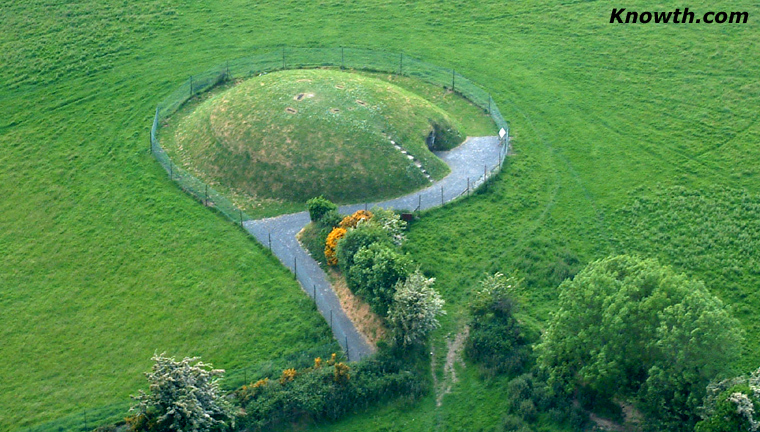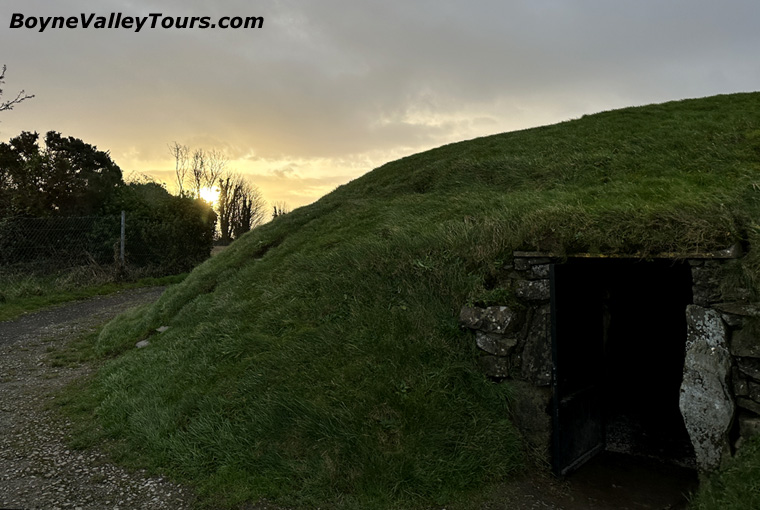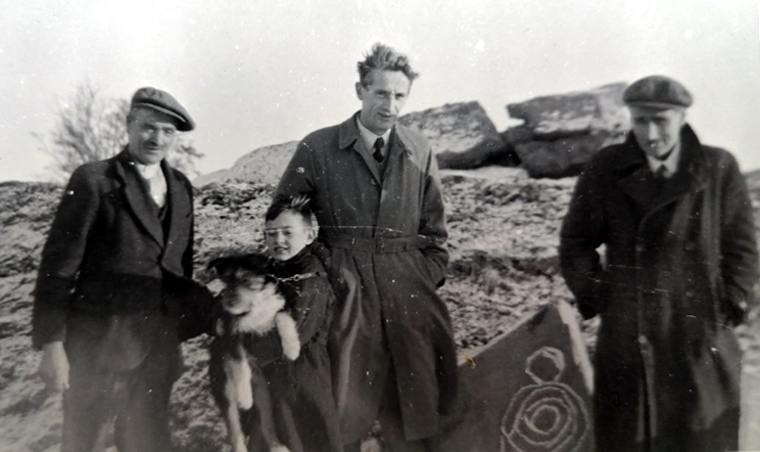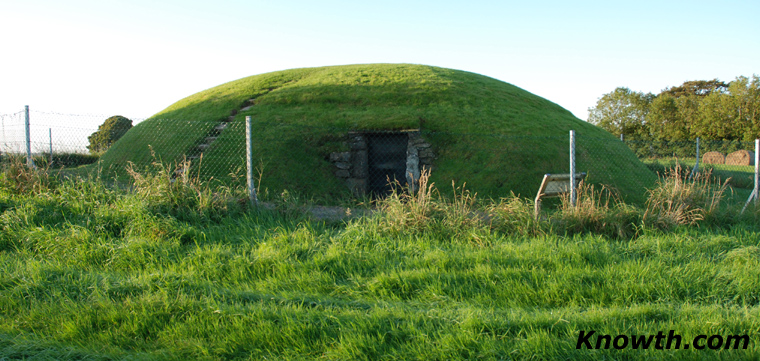Fourknocks is an ancient Passage Tomb constructed approximately 5,000 years ago, situated 10 miles (16km) southeast of Newgrange between Ardcath in County Meath and the Naul in County Dublin. The name Fourknocks is from the Irish Fuair Cnoic meaning Cold Hills.
Fourknocks features a short passage that opens into a spacious pear-shaped chamber, with three smaller offset chambers. The original roof was probably a wooden structure supported by a central pole. However, in 1952, following a two-year excavation, a modern concrete roof was installed to preserve the structural integrity.
During the excavation, a fascinating array of artifacts and human remains was unearthed within the tomb. Among the 65 burials discovered were both cremated and unburnt remains of adults and children. The site revealed an assortment of items, including intricately decorated pottery, vessels, and personal ornaments such as pendants and beads. In a bid to safeguard these valuable historical finds, all excavated items were relocated to the National Museum. The discoveries at Fourknocks provide valuable insights into the lives and practices of the ancient community that once inhabited the area.
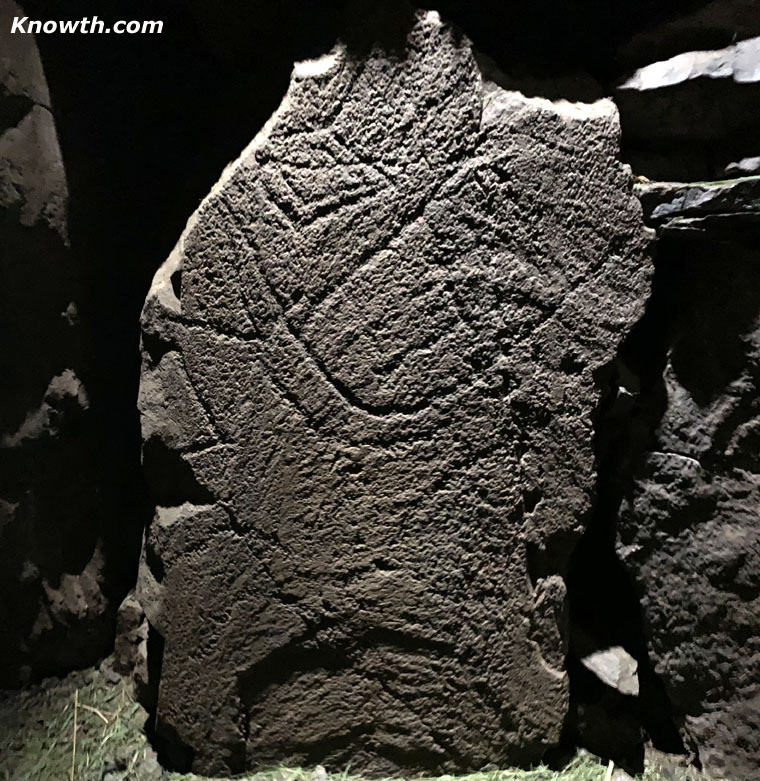
Fourknocks Face Stone | Possibily anthropomorphic (representing a human form)
Upon entering the chamber, one encounters a rare possible representation of a human face from the Neolithic Period in Ireland, positioned to the left of the entrance. Standing at approximately 3 feet (1 meter) in height, the Face Stone bears a resemblance to a prehistoric smiley face.
The key for the entrance door to Fourknocks Passage Tomb can be got from Mrs. Margaret White who lives a few minutes drive from the Tomb. Directions are signposted from Fourknocks. A cash deposit must be given which is refundable on the safe return of the key. The key should be returned before 6pm.
Two more Passage Tombs in the next field are overgrown with grass and furze bushes. There is no public access to these Monuments from the main Tomb with a "No Through Access" sign to discourage visitors from climbing over the fence.
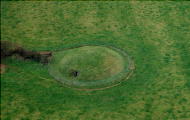 Images of Fourknocks.
Images of Fourknocks.There are two unexcavated sites in a field next to the main mound which are overgrown with grass and furze bushes. There is no public access to the unexcavated sites with a "No Through Access" sign to discourage visitors from climbing over the fence which surrounds the main mound.
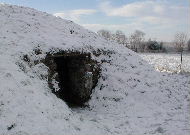 Fourknocks in the Snow. A snow covered landscape in Ireland is unusual, some winters pass without a
significant fall of snow. The images of a snow covered Fourknocks were taken on the 29th of December 2000.
Fourknocks in the Snow. A snow covered landscape in Ireland is unusual, some winters pass without a
significant fall of snow. The images of a snow covered Fourknocks were taken on the 29th of December 2000.
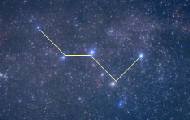 Fourknocks - An interpretation by Martin Dier.
A very interesting article exploring the less obvious reasons why structures like the Fourknocks
were sited where they were. Martin explores Archaeological Considerations, Astronomical Considerations,
Engineering, Geomantic Aspects, Yin and Yang, Psychodelia and Sacred Geometry.
Fourknocks - An interpretation by Martin Dier.
A very interesting article exploring the less obvious reasons why structures like the Fourknocks
were sited where they were. Martin explores Archaeological Considerations, Astronomical Considerations,
Engineering, Geomantic Aspects, Yin and Yang, Psychodelia and Sacred Geometry.
- Magic of Fourknocks by Brendan Matthews.
- Directions to Fourknocks including a roadmap of the local area.
- Greenanstown Stones, located a couple of miles from Fourknocks.
Meath Megalithic Sites - Private Hire Day Tour
Step into a realm of ancient wonders and mystical landscapes with our exclusive private day tour to Fourknocks and the Megalithic Passage Tombs of the Boyne Valley. Immerse yourself in the rich history and unparalleled beauty of these iconic sites as you embark on a journey through time. This personalized experience promises a day filled with awe-inspiring sights, intriguing stories, and memories to last a lifetime.Fourknocks stands as a hidden gem, quietly nestled in the heart of the Boyne Valley. While it shares the landscape with its more renowned counterparts, Newgrange and Knowth, its distinct charm and historical significance are often overshadowed by the grandeur of the more celebrated sites. Yet, within the unassuming allure of Fourknocks lies a treasure trove of archaeological wonders, patiently awaiting discovery by those who seek to unravel the mysteries of the past.
The Boyne Valley is home to some of the world's most significant Megalithic Passage Tombs, and our private tour ensures an intimate encounter with these marvels. Visit the majestic Newgrange, a UNESCO World Heritage site older than Stonehenge and the Egyptian pyramids. Marvel at the architectural ingenuity of Knowth, with its impressive array of megalithic art and intriguing satellite tombs. Feel the spiritual energy that permeates Dowth, connecting you to a sacred past.
Our private day tour is curated to cater to your interests and preferences. Whether you're a history enthusiast, a nature lover, or simply seeking a unique adventure, our experienced guides will tailor the itinerary to ensure an unforgettable experience. Bask in the personalized attention as you delve into the mysteries of Dowth and the Boyne Valley's ancient wonders.
Our knowledgeable guides are passionate about the history and folklore of the Boyne Valley. With in-depth expertise, they bring the past to life, weaving captivating narratives that transport you back in time. Learn about the rituals, beliefs, and traditions of the ancient people who left their mark on these extraordinary sites. Access to Newgrange and Knowth is exclusively facilitated by the official onsite guides. To explore these sites, you have to participate in a group tour.
Relax and enjoy the scenic beauty of the Boyne Valley as you travel in comfort and style. Our private day tour includes luxurious transportation, allowing you to focus on the experience without the hassle of logistics.
Boyne Valley Private Day Tour
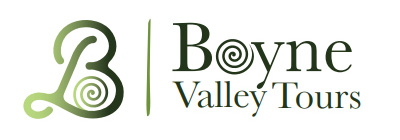 Immerse yourself in the rich heritage and culture of the Boyne Valley with our full-day private tours.
Visit Newgrange World Heritage site, explore the Hill of Slane, where Saint Patrick famously lit the Paschal fire.
Discover the Hill of Tara, the ancient seat of power for the High Kings of Ireland.
Book Now
Immerse yourself in the rich heritage and culture of the Boyne Valley with our full-day private tours.
Visit Newgrange World Heritage site, explore the Hill of Slane, where Saint Patrick famously lit the Paschal fire.
Discover the Hill of Tara, the ancient seat of power for the High Kings of Ireland.
Book Now
Home
| Newgrange
| Knowth
| Dowth
| Hill of Tara
| Fourknocks
| Loughcrew
| More Places
| Labyrinths
| Local Info
| Art Works
| Articles
| Images
| Books
| Links
| Boyne Valley Tours
| Contact

